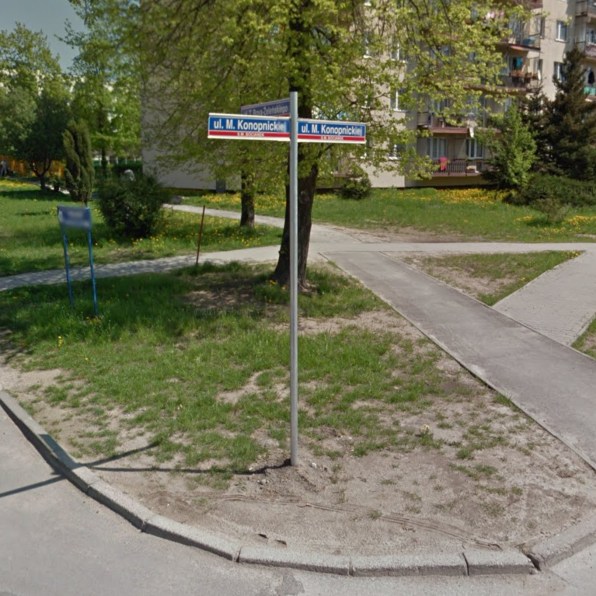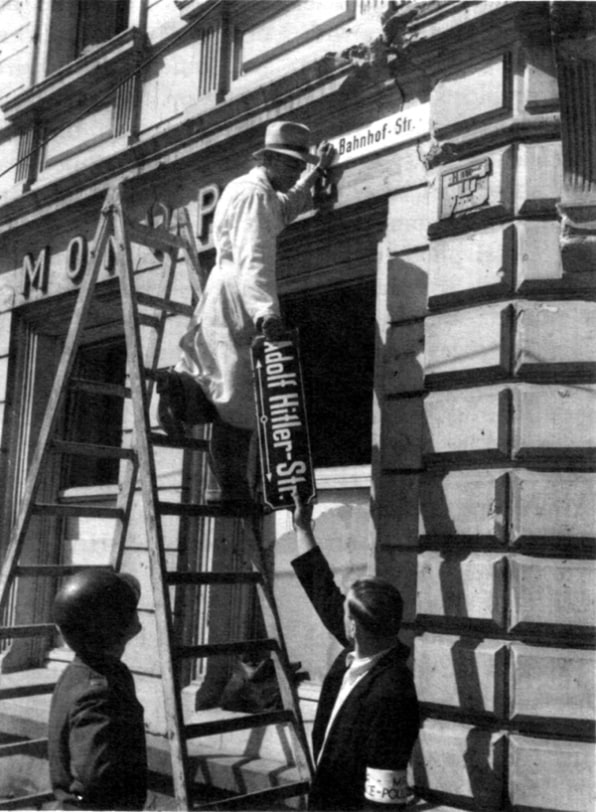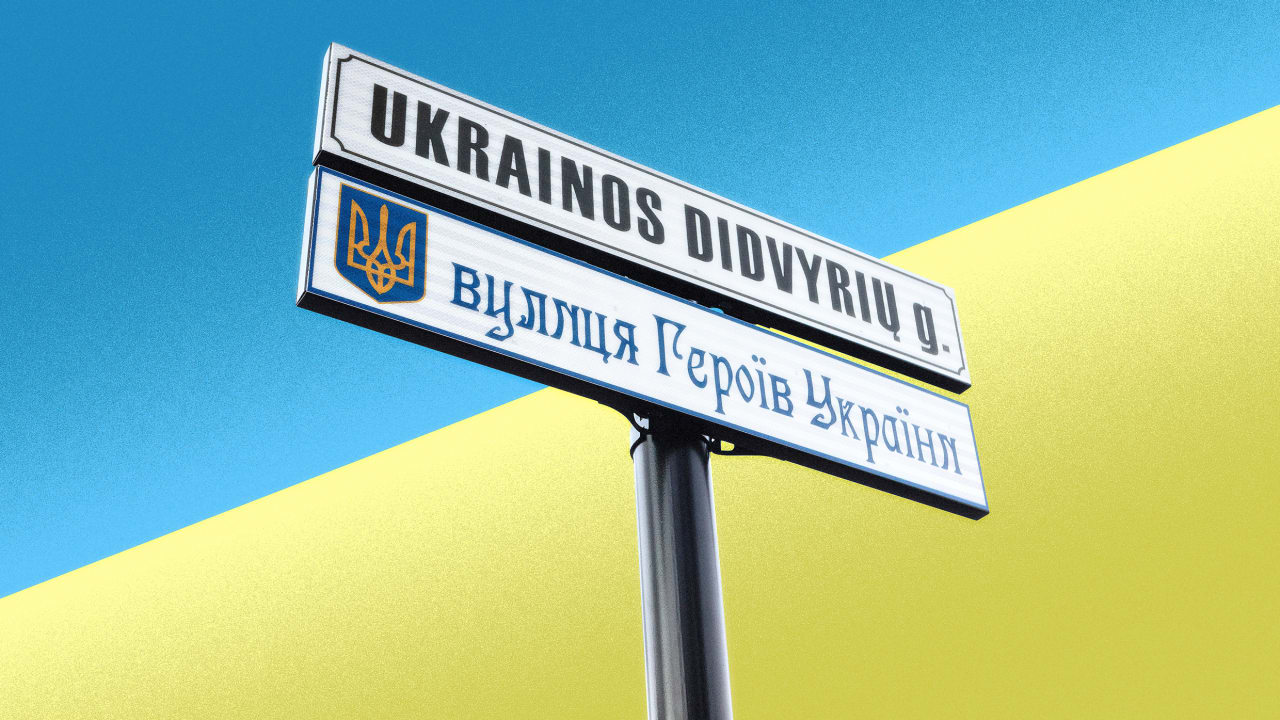How cities are using street names to protest Putin’s invasion of Ukraine
By Seraphim Alvanides Isabelle Buchstaller and Malgorzata Fabiszak 5 minutes Lily
Across Eastern Europe, addresses of Russian embassies are being changed in protest against the invasion of ukraine. In the Latvian capital, Riga, the section of Antonijas Street where the Russian Embassy is located is to be renamed Ukrainian Independence Street. And in Vilnius, Lithuania, the previously unnamed road on which the embassy is located (whose address referred to the nearest main street) has now become Ukrainians Didvyrių g.: Street of Ukrainian Heroes.
Historical events are inscribed in many urban landscapes. As part of an international multidisciplinary training research projectwe studied the evolution of street renaming patterns in East Germany and Poland over the past 100 years.
We documented all street name changes in three cities and towns of varying sizes in both countries: Leipzig, Annaberg-Buchholz and Frankfurt (Oder) in Germany; Poznań, Zbąszyń and Słubice in Poland. We have found that when a new regime comes to power, it asserts symbolic control on public space by renaming the streets that referred to the values and heroes of its predecessors.
Commemorative street naming
Names in medieval town centers are usually quite literal. They reflect the typical occupation of their former medieval inhabitants or the salient features of the street itself. In Frankfurt (Oder) we have Badergasse (“doctors’ alley”) and Zur Schmiedegasse (“blacksmiths’ alley”). In Poznan, ul. Dominikańska is located near the Dominican Church, while ul. Wielka, which translates to “high street”, was one of the widest streets leading from the city gates to the main market square.
In the 19th century, commemorative street names took precedence. The many examples of Frederick’s Street in former Prussian territories refer to one of the seven kings of Prussia called Frederick or Frederick William. Beyond monarchs and military commanders, renowned writers, painters, composers, scientists and industrialists have also taken their places on the street signs.
Together, in the cities we examined, these names form a nationalist cultural canon that is almost exclusively German/Polish and masculine. Highlighting them as street names encodes – or inscribes – this cultural tradition into the urban landscape.

When Europe’s borders were redrawn after World War I, Poznań changed its affiliation from Prussia to Poland. The German cultural pantheon (with names such as Johann Wolfgang von Goethe) quickly disappeared from the city’s street signs, to be replaced by a corresponding Polish canon (including the poet Maria Konopnicka).
This cultural shift also saw the language of the cityscape change from German to Polish. The topological, craft, and iconic street names may not have changed in meaning, but they have been translated. Bahnhofstrasse became ulica Dworcowa (meaning “station street” in both cases).
Building a cultural identity
Our research reveals that cities and towns also use street naming to express and construct their local cultural identities. Leipzig is famous for its publishing industry and thus features many streets named after local publishers and the writers and musicians whose works have been printed there. Poznań commemorates local social activism in the 19th century, Zbąszyń honors local folk bagpipe music, while Annaberg-Buchholz honors its mining traditions.
Successive socio-political regimes have imposed their ideological vision on the streetscape by commemorating their leaders or their values. Despite the fact that the Nazis had issued instructions explicitly discouraging the attribution of street names to living figures, in Nazi-occupied Poznań Heinrich Himmler and Hermann Göring were nevertheless commemorated at Heinrichplatz and in Hermannstadt, while Leipzig featured a street named after Hitler (Adolf-Hitler-Straße) from March 1933 to May 1945.
In the post-war period, the streets of the German Democratic Republic and the Polish People’s Republic went through a process of denazification. The names that replaced these Nazi references served, simultaneously, to encode communist symbolism. In August 1945, Adolf-Hitler-Straße in Leipzig thus became Karl-Liebknecht-Straße, commemorating the co-founder of the German Communist Party.
The fall of the Berlin Wall in 1989 led to the reunification of Germany and the establishment of a democratic government in Poland. This political change can be seen once again in the way the streets of German and Polish cities have been decommunized. Many reverted to earlier names.
In 1947, the communist administration of Poznań renamed ul. Bukowska (an orientation name, meaning “the street leading to the town of Buk”) to commemorate communist general Karol Świerczewski. In 1990, this name changed back to ul. Bukowska.

Since 1989, street renaming in Germany has often aimed to right past wrongs with the commemoration of journalists fighting for a free press, oppressed minorities under the Third Reich, or resistance fighters. This is the case in Frankfurt (Oder), with the ring road commemorating Ernst Heilborn, the Jewish writer and journalist persecuted by the Nazis.
Representation Matters
Street names also continue to serve as battlegrounds for representation, as local authorities use their power to influence who is remembered. Poznań added the names of 28 women to its streetscape in 2018, to celebrate 100 years of suffrage.
In Berlin, the Afrikanisches Viertel (African Quarter) in the northwest district of Wedding replaces the names of colonialists with those of African liberation fighters. Nachtigallplatz, for example, is named after Gustav Nachtigal, who led the colonization of Cameroon and Togo. It is fixed at become Bell-Platzto commemorate the Cameroonian royal family, including King Rudolf Duala Manga Bell, who fought against colonial repression and was executed by the Germans in 1914.
When street names are driven by ideology, there is initial excitement about renaming them, but over time opposition ensues. Residents send letters to local newspapers and petitions to council, for example. Conversely, when the story of the person commemorated in the street name is less well known, people tend to ignore it altogether. Few people remembered or cared who Julian Leński (a leader of the Polish Communist Party, who died in 1939) was, so a street named after him in Poznań was only changed in 2017.
Many claim that administrative burden involved in renaming – updating documents, business cards, letterhead, expensive street signs – do not always justify the effort to symbolically “repaint” the streetscape. What we have called “ideological fatigue” can cause new residential developments to opt for neutral names. Namely, Annaberg-Buchholz opted for minerals. And the Polish town of Słubice went for fruit.
Our project shows that in turbulent times, street names change, transforming history into the sedimented social geography of our cities.


Comments are closed.